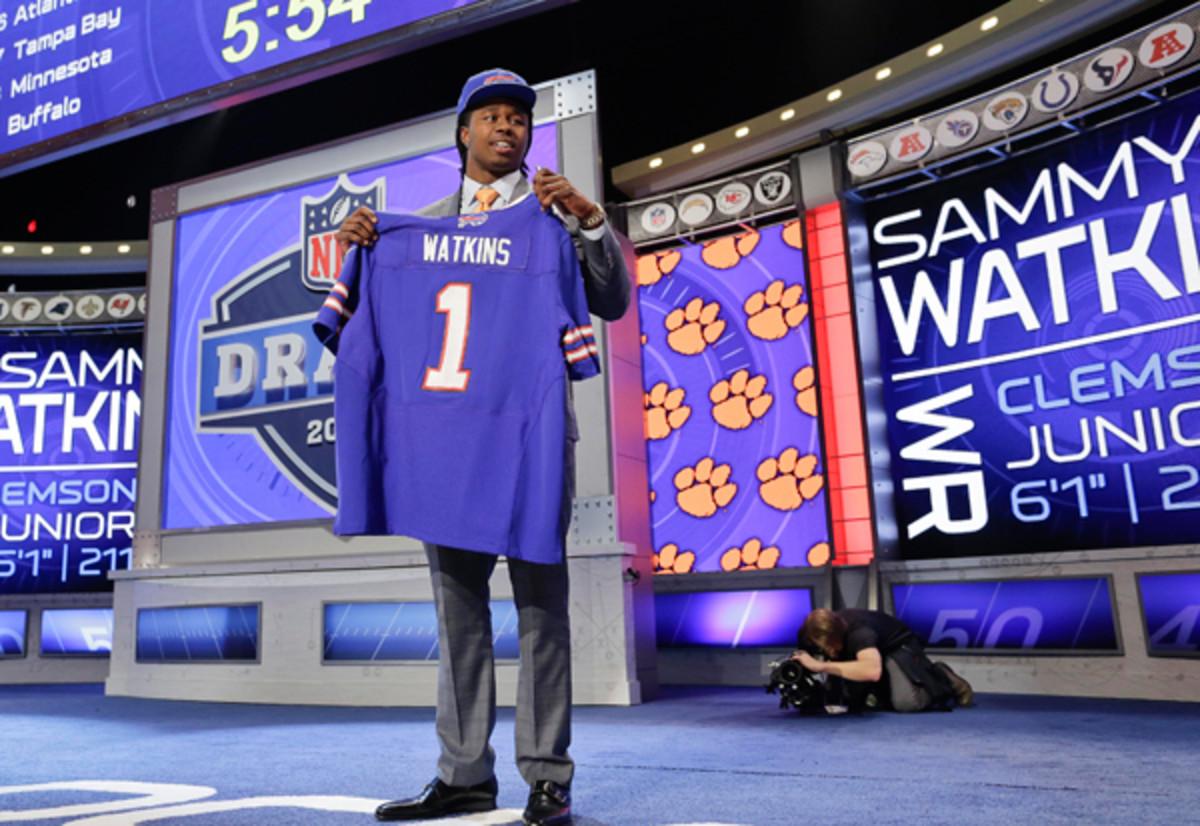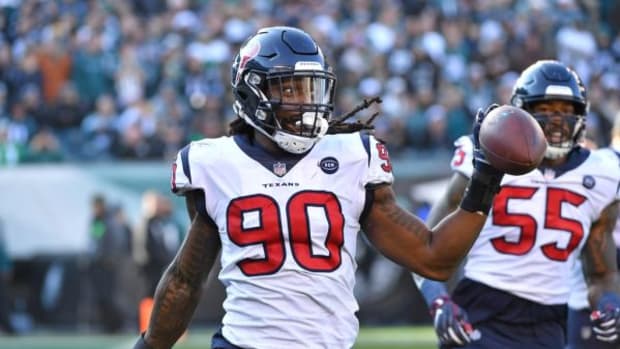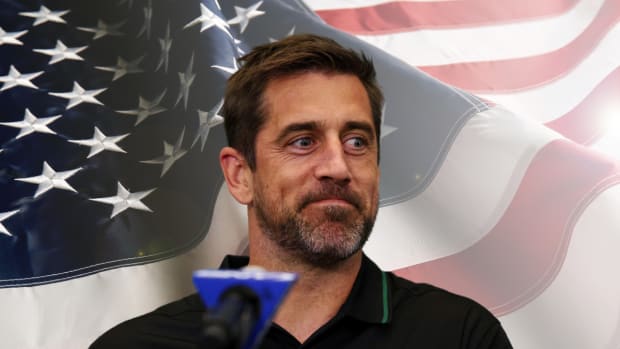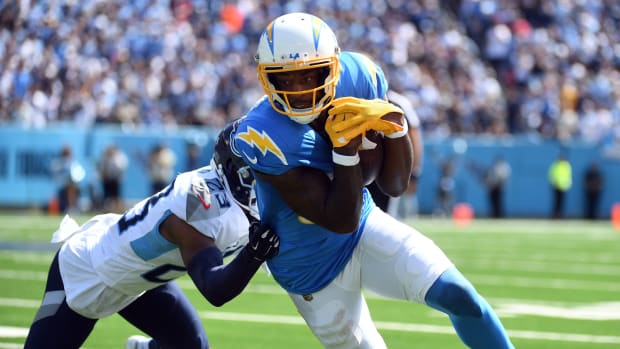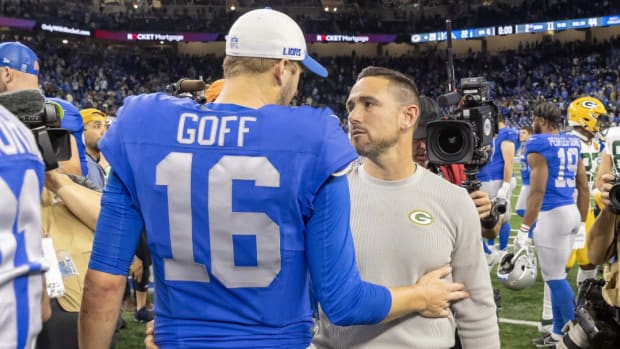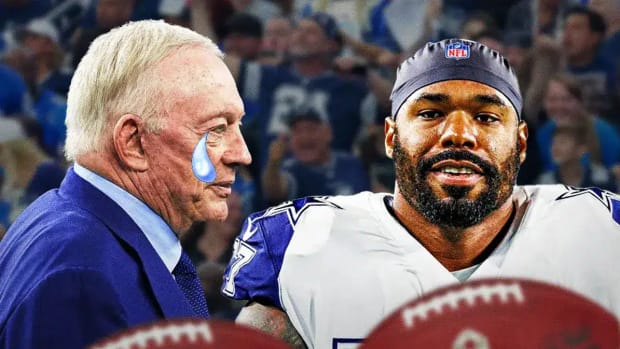Sammy Watkins, Darqueze Dennard could have biggest draft impacts for AFC teams
The Bills gave up a lot to get Sammy Watkins -- and they'll be expecting just as much. (Craig Ruttle/AP)
Teams always tell you that they don’t draft for need in a general sense, but after draft picks are made, it’s always easy enough to circle back and get coaches and general managers to admit that they did indeed go in certain positional directions. And there’s nothing wrong with that. While the ‘Best Player Available’ idea is great in theory, it’s often far more practical to address what needs addressing. Here’s one rookie for each AFC team who should pay immediate dividends based on talent and need.
Baltimore Ravens -- Linebacker C.J. Mosley
Since Ray Lewis' retirement, the Ravens have been looking for that linebacker whose football instincts and on-field talent would match up in a way that was even close to what Lewis used to bring to the table. And it's not automatic that Mosley will do that from day one, but the player who NFLDraftScout.com's Rob Rang says had "the keenest instincts of any linebacker I've scouted since Lofa Tatupu" could be a developing force in that direction. Ravens GM Ozzie Newsome took Mosley with the 17th overall pick, but assistant GM Eric DeCosta later said if his team had drafted in the top 10, Mosley still would have been the best player. As is required for elite linebackers in the NFL today, Mosley has an exciting combination of tackling toughness and outstanding field range. In 2013 alone, he had 108 tackles, nine tackles for loss, five pass deflections and eight quarterback hurries.
FARRAR: Deone Bucannon, Trai Turner could have biggest draft impacts for NFC teams
Buffalo Bills -- Receiver Sammy Watkins
When you trade away next year's first-round pick for a skill position player who isn't a quarterback, that player had best be transcendent. Otherwise, you wind up like the Colts, and their debacle of a Trent Richardson deal. When the Bills traded up five spots in this draft, surrendering their 2015 first- and fourth-round picks to select Clemson receiver Sammy Watkins, it was a clear indication that they see Watkins as their future. How they use Watkins is yet to be determined, but you should expect a lot of yards after the catch in Buffalo's 2014 offense. Watkins gained 71 percent of his receiving yards after the catch during his collegiate career, and he led the NCAA in YAC in 2013. Watkins is very dynamic on all kinds of short routes -- slants, bubble screens, short motion concepts -- and this could help second-year quarterback EJ Manuel in his development.
Cincinnati Bengals -- Cornerback Darqueze Dennard
With Terence Newman and Adam Jones on the wrong side of 30, and Leon Hall off his second Achilles surgery, there was little doubt that the Bengals needed to take a cornerback high in this draft. And there was also little question that in Dennard, Cincinnati saw a newer, healthier version of their best pass defender.
"When we worked him out, [co-DB coach] Vance [Joseph] and I said, 'That's Leon Hall,'" defensive coordinator Paul Guenther recently said. "He's technique-sound. He does what he's asked to do. All the coaches at Michigan State rave about the guy. He always takes the extra step to do things the right way. That's the kind of guy we want around here."
BANKS: Handing out grades for the good, bad, ugly from the offseason
In 2013, Dennard was the pointman in the Spartans' "No-Fly Zone" defense, and per ESPN, Michigan State allowed completions on just 23.7 percent of all opponent passes traveling 15 yards or more. Marvin Lewis has said that Dennard might not start right away, but he'll certainly get his turns in the rotation from the beginning.
Cleveland Browns -- Quarterback Johnny Manziel
Manziel has said since the combine that he knows the need to play more in the pocket and in structure, but he's closer to that ideal than some might believe. In 2013, per ESPN's Stats & Info, he completed an NCAA-best 73.5 percent of his passes from the pocket, while all three Browns quarterbacks combined to complete an NFL-low 56.9 percent of such passes. Add in his mobility, and seeming scheme fit with offensive coordinator Kyle Shanahan, and Manziel's effect could be enormous. On the downside, the possibility of leading receiver Josh Gordon's getting hit with a year-long NFL suspension could be equally enormous.
Denver Broncos -- Receiver Cody Latimer
The Broncos liked Latimer for a number of reasons -- the underrated receiver from Indiana blocks well, fights for the contested catch, doesn't drop passes, and is proud of his efficiency in the red zone. In 2013, he caught 72 passes for 1,096 yards and nine touchdowns, and one wonders what his stats would have been with better quarterbacks. That's not a problem for Latimer anymore, and he should be able to replace Eric Decker in Peyton Manning's receiver rotation pretty quickly.
“He’s big, fast, very tough and an outstanding blocker -- maybe the best blocker at the wide receiver position in the draft," head coach John Fox said after taking Latimer in the second round. "A guy that we think has tremendous upside -- big, physical and fast.”
BURKE: Veterans who should be nervous after the draft
[si_video id="video_40DB9000-9E1D-E496-8D57-FCB65C31FC17"]
Houston Texans -- Guard Xavier Su'a-Filo
The Texans ranked sixth in Football Outsiders' Offensive Adjusted Line Yards metric last season, but there was one obvious trouble spot in the run game -- the gaps between center and left tackle, where just three teams gained fewer yards per carry than Houston's 3.32. In 2013, left guard Wade Smith played 990 snaps at the position, per Pro Football Focus, and graded out as the 13th-worst run blocker among all qualifying guards in the NFL. Head coach Bill O'Brien has said that he likes Su'a-Filo's versatility and ability to play multiple positions, but you'll forgive the Texans for putting him at left guard for the next five years and being done with it. Su'a-Filo is a nasty, tough player who refers to himself as an "ass-kicker." The tape confirms this description. Su'a-Filo is an absolute road-grader with surprising agility, and with all the talk about Jadeveon Clowney, it's Su'a-Filo who might have the most immediate and dramatic impact on his new team.
Indianapolis Colts -- Offensive tackle Jack Mewhort
The Colts went into the 2014 draft without a first-round pick and with a clear need to improve their offensive line. In 2013, only left tackle Anthony Castonzo and right tackle Gosder Cherilus ranked positively in PFF's metrics. So, in the second round, Indy took Mewhort, the former first-team All-Big Ten tackle, with the thought in mind to convert him to NFL guard -- a position he did play at Ohio State from time to time. After the pick, GM Ryan Grigson couldn't have been happier.
"He had really good film at multiple positions," Grigson said. "We thought he played well at guard. And we thought he played well at tackle as well. And at the Senior Bowl was the moment we thought that, wow, this Mewhort guy might rise after that game. We were really happy. We really had him earmarked for a long time. We're really happy that we have him. I think he brings versatility, toughness, strength. Played at a high level at a high-level program where they're used to winning. So I think he fits our culture very well."
Jacksonville Jaguars -- Receivers Marqise Lee and Allen Robinson
The Jags made news when they took quarterback Blake Bortles with the third overall pick and basically declared that he would sit and learn for a year. So, it will be up to Lee and Robinson, each selected in the second round, to help Jacksonville's anemic offense for now. In 2013, Cecil Shorts led the team with 66 catches for 777 yards and three touchdowns. Combined, Lee and Robinson caught 154 passes for 2,223 yards and 10 touchdowns in 2013. Lee is a dynamic downfield target, while Robinson is a possession receiver with surprising speed. Whoever throws the ball for the Jags in 2014 will have a lot more help.
In a recent interview, Jacksonville senior vice president, football technology & analytics Tony Khan told me why his team is specifically excited about these two picks.
"Our scouts were incredibly high on Allen, and this was another case of the statistics saying something good about a player’s ability," Khan said of Robinson. "And it concurred with what they were thinking. Allen averaged 14.2 yards after the catch on screen passes, and Penn State threw a lot of screens. Allen was a very important part of Penn State’s offense, and if you were going to play Penn State, one would think that [an opponent] would spend a lot of time scheming to try to limit the damage Allen Robinson does to you. I thought it was very impressive, the numbers he was able to put up. And again, that’s a case of the tape matching up the stats.”
As for Lee... the Jags had him in mind since his freshman year, before a 2013 knee injury led to decreased productivity and Lee's slide out of his former status as a first-round prospect.
“If you look at his entire body of work, he’s been an incredibly dynamic receiver, and he’s been such a statistical marvel that after his freshman year, as my father was buying the Jaguars, we were regularly interacting with our West Coast scouts," Khan said of Lee. "We had been interested in him for many years, and Dave had been a highly regarded college scouting director, so he was interested as well. We wanted to get a good, young quarterback early in this draft, and then to get someone we regarded as an elite receiver with the 39th pick — that was something that we were very pleased to be able to do.”
[si_video id="video_52F10A9E-23DE-46DD-7674-E278AD14AD5E"]
Kansas City Chiefs -- DE/OLB Dee Ford
Though first-year defensive coordinator Bob Sutton did an amazing job with the Chiefs defense he inherited, not even he could mitigate the loss in quarterback disruption when Tamba Hali and Justin Houston were injured at various points through the season. So, with more depth in mind, Kansas City took the 6-2, 252-pound Ford in the first round, hoping that the 10.5 sacks and 14.5 tackles for loss he put up for Auburn in 2013 will transfer seamlessly to NFL production. Kansas City had just six total sacks in its six losses, though it finished sixth in the league with 47 overall. Ford will try to help the consistency process along.
BRANDT: Inside 10 trending topics in the NFL
"It's one thing to have a lot of sacks and it's one thing to have efficient sacks," the confident Ford said after he was drafted. "Anyone can go out and have 10 or 12 sacks (in a season); but when your team really needs you to end the game or end a drive and you have those sacks, those are very vital to your team. I want to always have productive, efficient sacks."
Miami Dolphins -- Offensive tackle Ja'Wuan James
Many were surprised that the Dolphins took James with the 19th overall pick. Everyone expected the team to address the obvious issues on its offensive line, but James was a bit of a sleeper, and wasn't often talked about in the media with the best of the tackles in this class. But in projecting him as a right tackle to bookend free agent acquisition Branden Albert, the Dolphins might have the last laugh. James is powerful and agile, and he's quick to rumble up to the second level. And at the very least, Dolphins fans won't have Tyson Clabo to kick around anymore. In 2013, Miami's former right tackle gave up 11 sacks and 31 total pressures, and the Dolphins ranked 24th in the league when running behind right tackle.
New York Jets -- Safety Calvin Pryor
The Jets cycled through Antonio Allen and Ed Reed opposite Dawan Landry in hope that their free safety position would be shored up, but that never materialized. So Rex Ryan and company took a decisive step with the 18th overall pick and chose Pryor, who had shown every explosive trait in pass coverage and run defense while at Louisville. He amassed three picks and 75 tackles in 2013, but Pryor is more than the sum of his stats -- to get the full picture, you need to watch his college tape and see how effortlessly (and at times, recklessly) he patrols the field.
BANKS: Eleven cities eyeing NFL draft if it leaves NYC
GM John Idzik wasn't worried about Pryor racking up penalties with his tackling style, which might be the only possible debit to his early potential.
"In viewing his tape, when he gets the impact hits, they aren't illegal hits," Idzik said. "They're just hard hits. We like having that style of play on our side."
New England Patriots -- Defensive tackle Dominique Easley
Bill Belichick has seen his share of hybrid defenders thorough his long career as a defensive coordinator and head coach, but few players give him the raw ability that Easley does. Were it not for the two knee injuries he suffered at Florida, Easley would be a sure top-10 pick -- and possibly the best defensive player in this draft class. When healthy, Easley simply destroys enemy blockers from any gap -- he can play from end to shade nose tackle, and he's eminently disruptive with his speed and strength from any position. The Pats took Easley with the 29th overall pick despite the injuries, and they weren't the only interested party -- the Seahawks reportedly traded out of the first round only after learning that Easley was out of the picture with the 32nd overall pick.
"He’s an explosive player," Belichick said after the pick was made. "There are a lot of good football players there and I think you can put on just about any film and watch him against quality players in the SEC or even Louisville last year -- there was plenty of good competition. You see him against guys that are either in the league from previous years or guys that you have on your draft board this year or you’re going to have on there next year. I think he’s a very disruptive player and he showed up against good competition."
If he can stay healthy, Easley has everything it takes to be a Defensive Rookie of the Year candidate.
BURKE: Clowney, Mack lead in handicapping the race for defensive ROY
Oakland Raiders -- Defensive tackle Justin Ellis
Yes, the selection of Khalil Mack with the fifth overall pick will graphically improve Oakland's linebacker rotation. But that's a bit of a no-brainer, and the Raiders were still on the lookout for a legitimate long-term replacement for monster defensive lineman Lamarr Houston, who departed in free agency. Ellis was an undervalued commodity at Louisiana Tech, but at 6-2 and 334 pounds, he could possibly do what Houston used to do for the Raiders as quite possibly their best overall player -- wreak havoc in multiple gaps. Far from a simple block-stuffing nose tackle, Ellis has the speed and agility (especially for his size) to disrupt in different roles.
Pittsburgh Steelers -- Linebacker Ryan Shazier
The Steelers picked Shazier with the 15th overall pick for one clear reason -- to help a run defense that struggled at the second level in 2013. Last season, per ESPN, Shazier was the only player in the FBS to total more than 100 tackles and 20 tackles per loss.
"He's a defensive playmaker," head coach Mike Tomlin said. "Bigger than anything, bigger than position needs, what we needed was a defensive playmaker... He is a guy who will be on his feet making sideline-to-sideline tackles associated with today's football. Quite frankly, the man doesn't have any holes."
Well, despite taking Shazier and Notre Dame Stephon Tuitt in the first two rounds, Pittsburgh still has holes in its front seven, the result of iffy drafts and personnel attrition. The rookies will certainly help, though.
San Diego Chargers -- Cornerback Jason Verrett
The need for the Chargers was as clear as any other NFL team had at any position -- to take the next step in the AFC West, San Diego had to get a great cornerback to move up from a pass defense that ranked 31st in Football Outsiders' metrics. Verrett is a smaller player (5-10, 189 pounds), which goes against the league's current trend, and he's had his share of injuries. GM Tom Telesco compared him to former Colts safety Bob Sanders in the way Verrett flies around with a physical style. That's all well and good, but step one is to keep him healthy. Step two is to find the best place on the field for him. Given what San Diego's cornerbacks did last season, step two shouldn't be too tough.
Tennessee Titans -- Running back Bishop Sankey
The Titans took Sankey with the 54th overall pick because with Chris Johnson out the door, and Shonn Greene as the only real alternative at the position, Tennessee's offense required a back who could do it all -- run inside with power, run outside with speed and agility, catch passes, and block well enough to be a true every-down threat. And in the person of the 5-10, 209-pound Sankey, the Titans got a back who proved to do all those things at Washington, despite an inconsistent offense around him. In 2013, Sankey gained 1,870 yards and scored 20 touchdowns on just 327 carries, and totaled 2,174 yards from scrimmage. He'll fill whatever role is needed from the start.
































